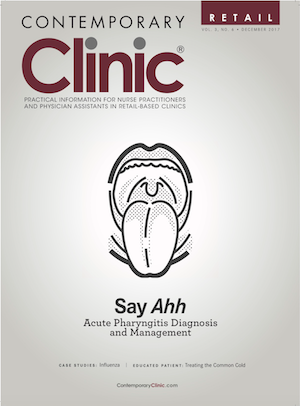Identifying Important Antibiotic Drug Interactions
To increase patient safety when treating infections, clinicians should be aware of clinically significant antibiotic drug interactions.
1
2,3
In 2014, US community pharmacies dispensed 266.1 million antibiotic courses to outpatients.About 48% of Americans have taken at least 1 prescription medication in the past month, and research shows that 81% of adults use OTC medicines as a first response to minor ailments.The increasing rate of medication use exponentially increases the probability of patients’ experiencing harmful drug—drug interactions. To increase patient safety when treating infections, clinicians should be aware of clinically significant antibiotic drug interactions.
Drug-Drug Interactions
4
When patients take 2 or more drugs concurrently, an effect other than what is achieved with each single drug may result. Drug—drug interactions may be pharmacokinetic or pharmacodynamic. Pharmacokinetic interactions relate to drug absorption, distribution, metabolism, and excretion. Pharmacodynamic interactions refer to the rela- tionship between drug concentration at the site of action and the resulting effect on the body.Drug interactions are usually divided into 4 groups (online table 15) . Drug interactions are not limited to prescription or OTC medications. Food in the stomach can increase or decrease drug absorption. Prescribed medicines and recreational drugs or natural products may interact, though these are often poorly researched.
High-Risk Antibiotic Drug-Drug InteractionsWarfarin
Almost all antibiotics can potentiate warfarin’s effects by eliminating intestinal flora/bacteria that produce vitamin K. Fluoroquinolones, macrolides, and sulfonamides can also inhibit warfarin’s metabolism, increasing its plasma concentrations and subsequently increasing anticoagulation and bleeding. Unless the prothrombin international normalized ratio can be monitored every other day, clinicians should generally avoid these antibiotics in patients who take warfarin. Alternative antimicrobials are recommended.
10
Fluoroquinolones
Fluoroquinolone antibiotics are useful in a variety of infections. However, several agents can substantially reduce fluoroquinolone absorption. Divalent cations (calcium, iron, and magnesium) and trivalent cations (aluminum) can chelate and form insoluble complexes in the gut that inhibit absorption if taken concurrently with fluoroquinolones. OTC products containing these cations, such as antacids, iron, and calcium supplements, are readily available, and patients often may not report them as medications. Retail health care clinicians should counsel patients to take these products 4 hours before or 4 hours after their fluoroquinolone antibiotic. Patients must also avoid dairy products.
12
Oral Contraceptives
11
Rifampin is the only antibiotic to date reported to reduce plasma estrogen concentrations. Insufficient evidence is available for interactions between oral contraceptives and other antibiotic regimens. However, it is difficult to separate any antibiotic effect from the baseline expected failure rate (1 pregnancy per 100 woman years) for oral contraceptives. Women should not rely on oral contraceptives for birth control while taking rifampin or other antibiotics, as the risk of pregnancy may increase. Clinicians should encourage patients to consider using an alternative method of contraception for the duration of any antibiotic regimen.Additional common drug—drug combinations and methods of interaction are summarized in table 2.6-13
Conclusion
Antibiotics can interact with many other medications, including prescription, OTC, and natural products. A good standard of practice is to obtain a full, current medication list before prescribing new antibiotic regimens. If questions arise, a variety of online medication interaction checkers are available, and local pharmacists are happy to serve as a resource.
Meghan Gagnon, PharmD,
is a PGY-1 resident at Lahey Hospital & Medical Center in Burlington, Massachusetts.
References
1. CDC. Outpatient antibiotic prescriptions — United States, 2014.cdc.gov/getsmart/community/pdfs/annual-reportsummary_2014.pdf. Accessed April 23, 2017.
2. CDC, National Center for Health Statistics. Therapeutic drug use.cdc.gov/nchs/fastats/drug-use-therapeutic.htm. Updated May 3, 2017. Accessed August 22, 2017.
3. Consumer Healthcare Products Association. Importance of Self-Care. Accessed April 15, 2017.
4. Spruill WJ, Wade WE, DiPiro, JT, et al.Concepts in Clinical Pharmacokinetics. 6th ed. Bethesda, MD: American Society of Health-System Pharmacists; 2014.
5. Types of drug interaction. NAM Publications website. www.aidsmap.com/Types-of-drug-interaction/page/1730473/. Accessed April 23, 2017.
6. Ament PW, Bertolino, JG, Liszewski JL. Clinically significant drug interactions.Am Fam Physician.2000;61(6):1745-1754.
7. Penicillin V potassium [prescribing information]. Eatontown, NJ: West-Ward Pharmaceutical Corp; 2014.medlibrary.org/lib/rx/meds/penicillin-v-potassium-17/page/3/. Accessed August 22, 2017
8. Septra (sulfamethoxazole/trimethoprim) [prescribing information]. New York, NY: Pfizer Inc; 2017.labeling.pfizer.com/ShowLabeling.aspx?id=706. Accessed August 22, 2017.
9. von Rosensteil NA, Adam D. Macrolide antibacterials. Drug interactions of clinical significance.Drug Saf.1995;13(2):105-122.
10. Baillargeon J, Holmes HM, Lin YL, Raji MA, Sharma G, Kuo YF. Concurrent use of warfarin and antibiotics and the risk of bleeding in older adults.Am J Med.2012;125(2):183-189. doi: 10.1016/j.amjmed.2011.08.014.
11. Zhanel GG, Siemens S, Slayter K, Mandell L. Antibiotic and oral contraceptive drug interactions: Is there a need for concern?Can J Infect Dis. 1999;10(6):429-433.
12. Fish, DN. Fluoroquinolone adverse effects and drug interactions.Pharmacotherapy.2001;21(10 Pt 2):253S-272S.
13. Del Rosso, JQ. Oral antibiotic drug interactions of clinical significance to dermatologists.Dermatol Clin. 2009;27(1):91-94. doi: 10.1016/j.det.2008.07.011.

